尼泊尔远西部野鸡分布及威胁笔记
IF 0.3
4区 生物学
Q4 ORNITHOLOGY
引用次数: 0
摘要
在尼泊尔许多地区,野鸡仍然是被研究最少但最受猎人和诱捕者攻击的物种。野鸡Catreus wallichii,被国际自然保护联盟列为珍稀易危物种,是尼泊尔国家鸟类红色名录中的濒危物种,也是尼泊尔九种重点保护鸟类之一。尽管它在全球和全国都很重要,但在尼泊尔及其活动范围的其他地区,它的数量一直在下降。诱捕和狩猎是尼泊尔大熊猫数量减少的主要原因。此外,对野鸡的科学研究和保护工作一直集中在少数保护区,而忽视了保护区系统之外的大片区域。尽管该物种的出现是偶然报道的,但在尼泊尔远西部地区没有进行过针对啦啦队野鸡的实地调查。因此,从2014年到2016年,我们在尼泊尔远西部的Baitadi、Achham和Bajura地区进行了一次调查和非正式访谈,以了解更多关于该物种的状况、分布和保护挑战。由于这项工作,在尼泊尔的新地点发现了齐尔野鸡,包括拜塔迪的Pancheshwor农村市、阿查姆的Mangalsen市和巴朱拉区的Badimalika市。尼泊尔远西部地区对该物种的主要人为威胁包括诱捕、射击、收集蛋和森林火灾。这个物种已经从过去当地人经常看到的一些地方消失了。因此,深入研究野鸡与潜在威胁之间的关系是必要的。此外,保护运动应该把重点放在狩猎团体和当地居民身上,因为该地区的意识很差。本文章由计算机程序翻译,如有差异,请以英文原文为准。
Cheer Pheasant Catreus Wallichii Distribution in Far-Western Nepal with Notes on Threats
Abstract Pheasants remain among the least studied but most popular species targeted by hunters and trappers in many parts of Nepal. Cheer Pheasant Catreus wallichii, is classified as rare and Vulnerable by the International Union for Conservation of Nature, an Endangered species in the National Red List of Birds in Nepal, and one of nine protected priority bird species of Nepal. Despite its global and national significance, it has been declining in Nepal, and in other parts of its range. Snaring and hunting are the main causes for its decline in Nepal. Furthermore, scientific research and conservation efforts for the Cheer Pheasant have been focused on a few Protected Areas (PAs), ignoring the large areas of its range that lie outside the PAs system. Despite the species' occurrence being reported opportunistically, no fieldwork focusing on Cheer Pheasant has been carried out in Far-Western Nepal. Therefore, from 2014 to 2016, a survey and informal interviews were conducted in Baitadi, Achham and Bajura districts of Far-Western Nepal to learn more about the species' status, distribution, and conservation challenges. As a result of this work, Cheer Pheasant has been found in new locations in Nepal, including Pancheshwor Rural Municipality in Baitadi, Mangalsen Municipality in Achham and Badimalika Municipality in Bajura District. The main anthropogenic threats to the species in Far-Western Nepal include trapping, shooting, egg collection, and forest fire. The species has already disappeared from some locations where local people observed them frequently in the past. Therefore, intensive study of the relationship between Cheer Pheasant and underlying threats is necessary. Additionally, conservation campaigns should be focused on hunting groups and local people, as awareness in the region is poor.
求助全文
通过发布文献求助,成功后即可免费获取论文全文。
去求助
来源期刊

Ornithological Science
ORNITHOLOGY-
CiteScore
1.20
自引率
0.00%
发文量
26
审稿时长
>12 weeks
期刊介绍:
Ornithological Science publishes reviews, original articles, short communications and comments covering all aspects of ornithology. Manuscripts are judged on the basis of their contribution of original data and ideas or interpretation. All articles are peer-reviewed by at least two researchers expert in the field of the submitted paper. Manuscript are edited where necessary for clarify and economy. Ornithological Science aims to publish as rapidly as is consistent with the requirements of peer-review and normal publishing constraints.
 求助内容:
求助内容: 应助结果提醒方式:
应助结果提醒方式:


